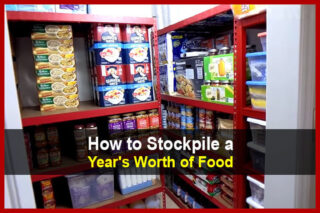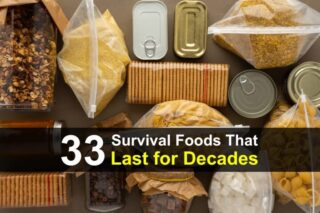Estimated reading time: 9 minutes
When you are stocking your emergency food supplies, you might be wondering how long they will last. The answer to that question depends on a few factors, including the type of food and how it is stored. In general, though, most food will last at least a year if it is stored properly.
But what do you do if you think that your emergency food has gone bad? Here are a few tips for detecting spoilage and getting rid of any unsafe food.
Want to save this post for later? Click Here to Pin It On Pinterest!
How Long Should Your Emergency Food Last?
One question that often comes up in discussions of emergency preparedness is how long emergency food should last.
The answer to this question depends on a number of factors, including the size of your family, the types of food you have stored, and your personal preferences. In general, non-perishable food items such as canned goods and dry goods can last for years, while perishable items such as fresh fruits and vegetables will only last for a few days.
Of course, it is also important to consider the expiration dates of your emergency food stores and rotate them accordingly. By taking these factors into account, you can ensure that you have enough food to last you through any emergency.
What Do Label Dates Actually Mean?
Have you ever wondered what those dates on food labels actually mean? It turns out that, with the exception of baby formula, there are no federal regulations on date labeling. The dates are simply a manufacturer's best guess about how long their food will taste its freshest.
Supermarkets may also use the dates as a guide when stocking shelves. However, the dates have little to do with how safe the food is. That’s why you might see different terminology used for these labels, like “expiration date,” “best used by date,” and so on.
So, next time you're deliberating over whether to eat that food that's been sitting in your fridge for a few weeks, don't worry too much about the expiration date. Chances are, it's still perfectly safe to eat.
How to Tell if Your Emergency Food Has Gone Bad
Most people don't think about emergency food until they need it. But if you're stuck in a disaster situation, the last thing you want is to find out that your emergency food has gone bad. Here are a few things to look for to tell if your food is still safe to eat.
Check the Expiration Date
The best way to tell if your food has gone bad is to check the expiration date. However, you should understand that the date is not everything. Just because a food has reached its expiration date does not mean it is necessarily bad. The date is simply an estimate of how long the food will remain fresh.
Many factors, such as storage conditions and the type of food, can affect how long a food will stay fresh. For example, canned goods can usually be stored for much longer than fresh produce. Therefore, it is important to use your judgment when deciding whether or not to eat a food that has reached its expiration date. If the food looks and smells normal, it is probably safe to eat.
However, if the food shows signs of spoilage, such as mold or an off odor, it should be discarded.
Smell It
When it comes to telling if food has gone bad, smell is one of the most reliable indicators. When food starts to spoil, it usually develops a distinct odor that is unpleasant to smell. If you're unsure whether food is still safe to eat, take a sniff before deciding.
In general, if the food doesn't smell right, it's probably best to throw it out. However, there are a few exceptions to this rule.
For example, some cheeses are supposed to smell bad, and eggs can develop a sulfur-like smell when they start to spoil. If you're not sure whether a particular food is safe to eat, err on the side of caution and throw it out. Better to be safe than sorry!
Look for Mold

You've probably heard the old saying, “If in doubt, throw it out.” When it comes to moldy food, that's sage advice. Mold is a type of fungi that can grow on both food and non-food sources.
While some types of mold are safe to eat (think: blue cheese), others can cause serious health problems. So how can you tell if food has gone bad? One surefire way is to look for mold.
Mold generally appears as a fuzzy or slimy growth on the surface of food. It can be white, black, green, or any other color, and it often has a musty or unpleasant odor.
If you see mold on food, it's best to err on the side of caution and throw it away. Eating moldy food can cause gastrointestinal distress, allergic reactions, and even infections in some people.
Signs of Insects
When it comes to emergency food, it's important to know how to tell if it has gone bad. After all, you don't want to find yourself in a situation where you're eating food that has been infested with insects. There are a few signs to look for that will indicate whether or not your food has been contaminated.
One is the presence of actual insects in the food. Another is the presence of small holes in the packaging. This is typically an indication that insects have already made their way into the food.
Finally, look for small piles of waste near the food. This is another sign that insects have been present. If you see any of these signs, it's best to discard the food and find a new source.
Leaking Juice or Food
Sealed food containers that are leaking juice or food are no longer safe to eat. The food inside has come into contact with air and bacteria, and it is now at risk of spoiling.
Even if the food looks and smells fine, it may contain harmful bacteria that can cause food poisoning. If you come across a container of leaking food, discard it immediately.
Foam on Top of the Food
One way to tell if your emergency food has gone bad is if there is foam on top of the food. This is a sign of spoilage and means that the food should not be eaten. If you see foam on top of your emergency food, discard it immediately and replace it with fresh supplies.
Canned Food – Does It Look Slimy?
Another surefire way to tell if canned food has gone bad is to look for signs of slime. If the can is covered in slime, or if the food inside is slimy, it's a good indication that the food has gone bad and should be thrown away.
Excessive Pressure Release When Opening a Jar
Another way to tell if your emergency food has gone bad is by looking for signs of excessive pressure release when opening a jar. If the lid pops off with more force than usual, or if there is a hissing sound when you open the jar, this may be an indication that the food inside has started to deteriorate.
Bubbles in Canned Food
Yet another way to tell if canned food has gone bad is to look for bubbles. When metal cans get old, the seals start to break down and allow air to enter. This causes the contents of the can to expand, resulting in small bubbles. In addition, the canned food may start to bulge or swell.
Cloudy Liquid in Canned Goods
While most canned goods have a shelf life of several years, there are a few signs that can indicate that the food has gone bad. One of these is cloudy liquid in the cans. This usually happens when the canning process was not done correctly, allowing oxygen to enter the can and react with the food.
Cloudy liquid can also be a sign of spoilage, so it's important to check for other signs of deterioration before consuming any food from a can with cloudy liquid.
Are the Lids Bulging, Rusted, or Dented? Or Do They Pop Back Up?

For canned goods, check the condition of the lids. If they are bulging, rusted, or dented, there's a good chance the food inside has gone bad. Another telltale sign is if the lids pop back up when you press down on them. If so, the food is probably spoiled.
Does it Look Fresh?
A simple way to tell if food has gone bad is to take a look at it. If the food looks fresh, then it's likely still safe to eat. However, if the food looks discolored or has developed mold, it's best to throw it away.
Avoiding Future Waste
There are a few simple steps that everyone can take to avoid wasting food. For example, freezing produce can help it last longer. And knowing how to properly store canned or frozen food can also help to extend its shelf life.
Composting is another great way to reduce food waste. Not only does it provide nutrients for plants, but it also helps keep organic material out of landfills.
Finally, getting organized can go a long way towards preventing food waste. Taking the time to plan meals and make shopping lists can help ensure that food is used before it goes bad.
Final Thoughts
If you’re like most preppers, you have a stash of food in your pantry and/or fridge that you can eat in case of an emergency. But what happens if that food has gone bad? Do you know how to tell? Consider this your guide to sniffing out spoiled food before it makes you sick.
Like this post? Don't Forget to Pin It On Pinterest!












